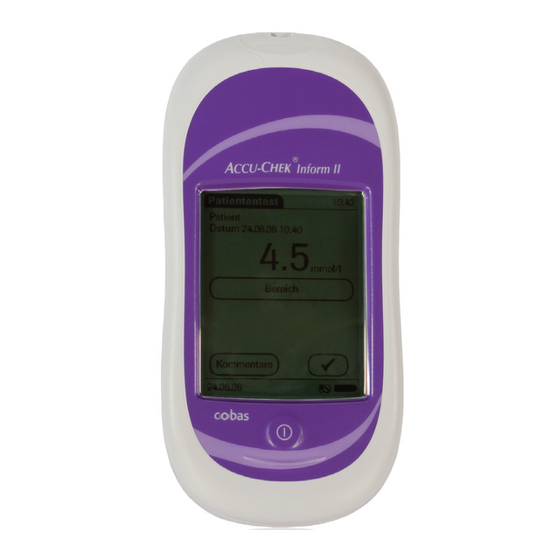
Summary of Contents for cobas Accu-Chek Inform II
- Page 1 Inform II Guide for Trainers 6452 AccuCheck Inform II linktrainer21.2.11.indd 1 24/02/2011 10:31...
- Page 2 How to use Thank you for being a Link Trainer for Point of Care Testing (Blood Glucose). This document is to be used as a guide to enable a progressive learning experience during blood glucose training sessions that you deliver. The information and instructions contained in this document are for guidance only and do not supersede the information and instructions contained in the Operator Manual, Package Inserts, Hospital Standard Operating Procedures (SOP) or Product Bulletins.
- Page 3 Link Trainer for Inform II The Roles And Responsibilities To casacade training and updates to all staff that perform Point of Care Testing on the Ward/Department at agreed intervals. The training must include reference to Hospital Policies, Contra-Indications and Test Interferences. To maintain a record of all staff trained or updated and to give a copy of this record to the relevant person/authority within the Trust.
- Page 4 Tools needed for the training session Meter Notes Strips QC solutions Lancing device Local Blood Glucose testing policy Attendance sheet 6452 AccuCheck Inform II linktrainer21.2.11.indd 4 24/02/2011 10:31...
- Page 5 Training Guide Sections 1. Why Training? 2. Meter and Strips 3. Quality Control 4. Patient Preparation 5. Laboratory Involvement 6. Further Reading and References 6452 AccuCheck Inform II linktrainer21.2.11.indd 5 24/02/2011 10:31...
- Page 6 1. Why Training? Q: Who says it is important? A: Department of Health MHRA All nursing staff are responsible and accountable for ensuring that they keep up to date with their personal training needs. Local Policy Notes Reference: Section 6 of this document 6452 AccuCheck Inform II linktrainer21.2.11.indd 6 24/02/2011 10:31...
- Page 7 2. The Meter Explain Notes Connected meter Automatic data transfer Test Strip Port Operator ID: unique and never shared Patient ID: audit trail and clear identification of results Barcode scanning of both Touch Screen Show On/Off button Touchscreen Press with fingertips only What to do if damaged Scanner On/Off...
- Page 8 2. The Strips Q: Why must the lid be kept closed? A: Accurate results; patient Show pot of strips safety Clean dry hands Importance of closed lid Notes Information on the label Explain Calibration done centrally Show single strip Gold end in meter Where and when to dose Golden End Measurement range of meter...
- Page 9 3. Quality Control Q: When do you run a QC Test? A: Hospital policy/pot change/ unexpected patient result/ QC is run to test the accuracy of dropped meter Meter Notes Strips QC Solution Operator Show Running a QC Explain Getting rid of the first drop Expiry dates (3 months from opening) Content of solutions (Sugar water &...
-
Page 10: Troubleshooting
3. Quality Control: Maintenance Explain Notes Cleaning meter What to use daily What to use for blood contamination Where to obtain New strips New solution New meter New workstation Troubleshooting Reference: Chapter 10 and 11 of Operator manual 6452 AccuCheck Inform II linktrainer21.2.11.indd 10 24/02/2011 10:31... -
Page 11: Infection Control
4. Patient Preparation Q: What are the risks of improper handwashing? A: Erroneous results; Explain Inappropriate treatment; Gain consent Patient infection (show photo if appropriate) Handwashing Water and non-lint gauze Notes Dry thoroughly Infection Control Suitable sites for lancing Importance of finger choice Where to avoid Neonatal choices What lancing device... - Page 12 5. Laboratory Involvement Q: When should you not use a capillary sample? A: Dehydration; Diabetic Keto- Explain Acidosis (DKA); Shock; Hyperosmolar non-ketotic coma When to take a venous sample (HONK); Peripheral occlusive Why a venous sample should be used disease; hypotension; Where the venous sample should be sent decompensated heart failure NYHA Class IV ;...
- Page 13 6. Further reading and references Training Key Points • Always check for contra-indications & test interferences, details of which are found in the strip pack insert and the Operator Manual. • The code chip in each pot of test strips is for calibrating unconnected meters. •...
- Page 14 Sandler, M. et al. Misleading Capillary Glucose Measurements. Practical Diabetes, 7: 210 (1990) Wickham, N.W.R et al. Unreliability of Capillary Blood Glucose in Peripheral Vascular Disease Practical Diabetes, 3: 100 (1986) Further Reading: www.roche-diagnostics.co.uk www.diabetes.ie www.cobas-roche.co.uk www.nmc-uk.org.uk www.mhra.gov.uk www.rcn.org.uk www.imb.ie www.nursingboard.ie www.diabetes.org.uk...
- Page 15 COBAS, ACCU-CHEK and LIFE NEEDS ANSWERS are trademarks of Roche © 2010 Roche Information correct at time of going to print, 2010 Roche Diagnostic Limited, Charles Avenue, Burgess Hill, RH15 9RY Head office 01444 256000 www.roche-diagnostics.co.uk 6452 AccuCheck Inform II linktrainer21.2.11.indd 15...


Need help?
Do you have a question about the Accu-Chek Inform II and is the answer not in the manual?
Questions and answers